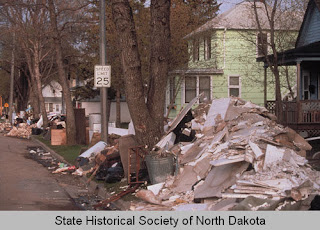Bakken, R. (1998). Come hell and high water.
"We fought this thing. We fought it all night long. We fought and fought and fought" Mary Anderson, East Grand Forks resident
Monday, October 29, 2012
Video Clip the day the dike broke
This video shows clips of April 18th the day the dike broke.
Red Cross Helps
Father of Nehrams2020 (1997). Retrieved on October 30, 2012, from http://en.wikipedia.org/wiki/1997_Red_River_Flood_in_the_United_States.
Many people came to help clean up and donate items to victims. Other organizations other than the Red Cross were FEMA and the National Guard.
Many people came to help clean up and donate items to victims. Other organizations other than the Red Cross were FEMA and the National Guard.
Sunday, October 28, 2012
Graphs of Flood Stages
Graphs of Flood Stages from Grand Forks gaging station. From these graphs we can see that it is a normality for this area to flood every year. It is also clear that in the year 1997, the Red River of the North crested at the highest point ever recorded at 54.35 feet.
North Dakota water science center. (2012) Retrieved on October 29, 2012 from: http://nd.water.usgs.gov/floodtracking/charts/05082500.html
Example of other student activities
This website is one that somebody (author unkown) put together as a unit lesson plan with activities for students. Most of the links to other websites are no longer working. There are other links however to student activities that do work. Answer keys are included as well as extension activities. For the purpose of this blog and ideas that could be used with students, it is a good starting point.
This topic could be used to teach what being a community is all about, and helping each other through times of need. People came together to help prepare houses for flooding, housing those who had already been evacuated, donating items to help clean afterwards, monetary donations from an anonymous donor (Angel), and the love and support of the community.
These pictures help portray the damage that was done as well as the help the community was given and what it took to "clean" the city.
Other things that could be added in the future would be pictures of the blizzards from the winter before (Elmo and Hannah), and the fire that took place in downtown Grand Forks during the flood that destroyed 11 blocks.
Other social studies topics that could be included besides community would be geography (what geographical features allowed this type of flooding to happen?) or economics (how much money was lost, how much money was needed to repair the city etc.)
This website is one that somebody (author unkown) put together as a unit lesson plan with activities for students. Most of the links to other websites are no longer working. There are other links however to student activities that do work. Answer keys are included as well as extension activities. For the purpose of this blog and ideas that could be used with students, it is a good starting point.
This topic could be used to teach what being a community is all about, and helping each other through times of need. People came together to help prepare houses for flooding, housing those who had already been evacuated, donating items to help clean afterwards, monetary donations from an anonymous donor (Angel), and the love and support of the community.
These pictures help portray the damage that was done as well as the help the community was given and what it took to "clean" the city.
Other things that could be added in the future would be pictures of the blizzards from the winter before (Elmo and Hannah), and the fire that took place in downtown Grand Forks during the flood that destroyed 11 blocks.
Other social studies topics that could be included besides community would be geography (what geographical features allowed this type of flooding to happen?) or economics (how much money was lost, how much money was needed to repair the city etc.)
Subscribe to:
Comments (Atom)








